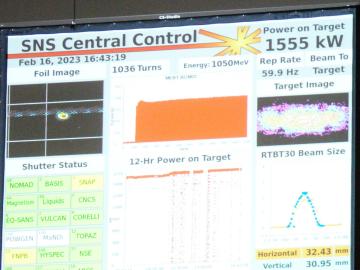Filter News
Area of Research
- (-) Biology and Environment (40)
- (-) Neutron Science (77)
- Advanced Manufacturing (13)
- Biological Systems (14)
- Biology and Soft Matter (1)
- Building Technologies (3)
- Chemistry and Physics at Interfaces (4)
- Clean Energy (167)
- Climate and Environmental Systems (2)
- Computational Biology (4)
- Computational Engineering (2)
- Computer Science (4)
- Energy Frontier Research Centers (7)
- Energy Sciences (2)
- Fossil Energy (2)
- Fuel Cycle Science and Technology (1)
- Functional Materials for Energy (6)
- Fusion and Fission (17)
- Fusion Energy (2)
- Geographic Information Science and Technology (2)
- Isotope Development and Production (1)
- Isotopes (8)
- Materials (204)
- Materials Characterization (2)
- Materials for Computing (13)
- Materials Synthesis from Atoms to Systems (5)
- Materials Under Extremes (5)
- National Security (24)
- Nuclear Science and Technology (24)
- Nuclear Systems Modeling, Simulation and Validation (1)
- Nuclear Systems Technology (1)
- Quantum Condensed Matter (1)
- Quantum information Science (1)
- Reactor Technology (1)
- Sensors and Controls (1)
- Supercomputing (107)
- Transportation Systems (5)
News Type
News Topics
- 3-D Printing/Advanced Manufacturing (9)
- Advanced Reactors (1)
- Artificial Intelligence (4)
- Big Data (2)
- Bioenergy (11)
- Biology (18)
- Biomedical (9)
- Biotechnology (5)
- Buildings (2)
- Chemical Sciences (8)
- Climate Change (8)
- Composites (3)
- Computer Science (11)
- Coronavirus (10)
- Critical Materials (1)
- Cybersecurity (1)
- Decarbonization (3)
- Energy Storage (7)
- Environment (16)
- Frontier (1)
- Fusion (1)
- Grid (1)
- High-Performance Computing (6)
- Isotopes (2)
- Machine Learning (2)
- Materials (15)
- Materials Science (16)
- Microscopy (4)
- Molten Salt (1)
- Nanotechnology (11)
- National Security (2)
- Net Zero (1)
- Neutron Science (40)
- Nuclear Energy (2)
- Partnerships (5)
- Physics (8)
- Polymers (1)
- Quantum Science (4)
- Security (2)
- Simulation (4)
- Space Exploration (1)
- Summit (7)
- Sustainable Energy (6)
- Transformational Challenge Reactor (1)
- Transportation (4)
Media Contacts

Like most scientists, Chengping Chai is not content with the surface of things: He wants to probe beyond to learn what’s really going on. But in his case, he is literally building a map of the world beneath, using seismic and acoustic data that reveal when and where the earth moves.

In a discovery aimed at accelerating the development of process-advantaged crops for jet biofuels, scientists at ORNL developed a capability to insert multiple genes into plants in a single step.

Shih-Chieh Kao, manager of the Water Power program at ORNL, has been named a fellow of the American Society of Civil Engineer’s Environmental & Water Resources Institute, or EWRI.

Colleen Iversen, ecosystem ecologist, group leader and distinguished staff scientist, has been named director of the Next-Generation Ecosystem Experiments Arctic, or NGEE Arctic, a multi-institutional project studying permafrost thaw and other climate-related processes in Alaska.

A team of scientists led by the Department of Energy’s Oak Ridge National Laboratory designed a molecule that disrupts the infection mechanism of the SARS-CoV-2 coronavirus and could be used to develop new treatments for COVID-19 and other viral diseases.

ORNL has entered a strategic research partnership with the United Kingdom Atomic Energy Authority, or UKAEA, to investigate how different types of materials behave under the influence of high-energy neutron sources. The $4 million project is part of UKAEA's roadmap program, which aims to produce electricity from fusion.

ORNL's Spallation Neutron Source set a world record when its linear accelerator reached an operating power of 1.55 megawatts, which improves on the facility’s original design capability.

ORNL staff members played prominent roles in reports that won one Distinction award and two Excellence awards in the 2022 Alliance Competition of the Society for Technical Communication. PSD's Karren More and Bruce Moyer participated.

Oak Ridge National Laboratory scientists set out to address one of the biggest uncertainties about how carbon-rich permafrost will respond to gradual sinking of the land surface as temperatures rise.

A quest to understand how Sphagnum mosses facilitate the storage of vast amounts of carbon in peatlands led scientists to a surprising discovery: the plants have sex-based differences that appear to impact the carbon-storing process.




